Physical Address
304 North Cardinal St.
Dorchester Center, MA 02124
Lymphoid tissues are the sites where precursor cells mature into immunocompetent lymphoid cells and where immune reactions to antigens occur. The lymphoid tissues and the stages of lymphocyte differentiation and maturation have an anatomy—they occur at specific sites in the body. They have an architecture—each lymphoid tissue is organized in a specific way, and cellular differentiation and reactions occur in specific sites within this organized tissue. They have a specific cellular morphology—the cells change size, shape, and other features as they mature and react to antigen and other stimuli. They undergo specific genetic and biologic changes—lymphoid cells alter their genes, their gene expression, and the proteins they produce and respond to at the various stages of differentiation and maturation. Understanding these normal structures and their alterations during lymphoid cell development and activation and during immune responses is important for pathologists who must diagnose reactive and neoplastic conditions of lymphoid tissues and cells.
Superimposed on this lymphoid tissue anatomy is the biology of the immune system. The function of the immune system is to defend against infection. Its cellular components include phagocytic cells (neutrophils, monocytes, and histiocytes or macrophages), lymphocytes (T cells, B cells, and natural killer [NK] cells), and antigen-presenting cells (histiocytes, dendritic cells, and B cells). There are two distinct types of immune reactions: innate or natural immune responses, and acquired or adaptive immune responses. Innate immune responses are carried out by phagocytes, dendritic cells, NK cells, and some T cells, including gamma-delta T cells, which respond in the same way regardless of prior exposure to antigen. Adaptive immune responses involve antigen-specific T cells and B cells and are modified by prior exposure to antigen.
Antigen recognition in the innate immune system is mediated by receptors encoded in the germline DNA. Since the existence of the first multicellular organisms, these receptors have evolved to recognize a limited number of highly conserved structures that are present on common pathogens—so-called pathogen-associated molecular patterns—but are not present on host cells. These include bacterial lipopolysaccharides, yeast cell-wall mannans, bacterial DNA, and others. In contrast, antigen recognition in the adaptive immune system is mediated by receptors generated somatically in B and T cells, yielding a wide variety of surface receptors, only some of which have useful specificity. Those that are dangerous (i.e., having anti-self specificity) must be selected against, whereas those that are useful (i.e., specific for pathogens) must be selected for by clonal expansion on exposure to antigen. The adaptive immune response improves in efficiency and specificity during the life of the individual owing to repeated exposure to antigen, but by definition, this cannot be passed on to progeny. Another major difference between the innate and adaptive responses is that innate immune cells perform their effector functions immediately upon receptor engagement, whereas cells of the adaptive response first proliferate in response to antigen. In addition to the rapid recognition and control of pathogens, cells of the innate immune system initiate and regulate adaptive immune responses by presenting antigen and activating signals to T cells and B cells.
Lymphoid tissues are divided into two major compartments, according to lymphoid cell differentiation stages and functional interactions: central or primary lymphoid tissues, and peripheral or secondary lymphoid tissues. The central lymphoid tissues are the bone marrow and thymus. These organs contain the precursor lymphoid cells and sustain the initial antigen-independent differentiation process from immature cells to the mature stage, at which they can perform their function in response to antigens. The peripheral or secondary lymphoid organs are the lymph nodes, spleen, and mucosa-associated lymphoid tissue (MALT), where the mature lymphoid cells encounter antigens and develop different types of immune responses. These compartments are highly organized microenvironments of different cell populations, vascular structures, and stromal components that maximize the selective interactions between lymphocytes and antigens for the initiation and expansion of the immune responses.
Bone marrow is the source of self-renewing populations of stem cells, including the precursors for hematopoietic stem cells and early common lymphoid B-cell and T-cell precursors. The early B-cell differentiation program continues in the bone marrow, whereas the precursor elements committed to T-cell differentiation migrate to the thymus to complete the process. Bone marrow is also a repository for plasma cells that migrate back to the bone marrow after being generated in peripheral lymphoid organs and tissues. Previous concepts involved a topographic distribution of hematopoietic stem cells in paratrabecular areas, whereas B-cell precursors moved to the central bone marrow spaces. This view is being challenged by the observation of hematopoietic stem cells throughout the bone marrow. The mesenchymal stem/stromal cell is a subset of stromal cells that plays a relevant role in sustaining normal and neoplastic hematopoiesis in the bone marrow.
Early B-cell differentiation is recognized by the expression of the B-cell marker CD19, associated with CD34 and later CD10. These cells express terminal deoxynucleotidyl transferase (TdT), RAG1, and RAG 2 involved in immunoglobulin gene rearrangements. CD19 is expressed throughout the entire B-cell differentiation program, whereas CD34 and later CD10 are lost in the bone marrow process at the same time the B-cell marker CD20 is expressed and the immunoglobulin gene is rearranged and expressed in the surface membrane of the cell. The early T-cell–committed elements in the human bone marrow are not well defined.
Cytokines and chemokines influence B-cell differentiation and trafficking in the bone marrow ( Table 8-1 ). One of the major players is CXCL12, also known as stromal cell–derived factor-1 (SDF-1), and its receptor, CXCR4. CXCL12 is expressed by osteoblasts, bone marrow stromal cells, and endothelial cells. CXCR4 is present in hematopoietic stem cells and in early stages of B-cell differentiation, whereas it is downregulated in pre–B cells and mature B cells in peripheral lymphoid organs. It is upregulated again after antigen stimulation and plasma cell differentiation, which may explain the homing back of these cells to the bone marrow.
| Cell | Chemokine | Chemokine Receptor | Cell |
|---|---|---|---|
| Bone Marrow Osteoblasts Endothelium Stromal cells Splenic Red Pulp Stromal cells |
CXCL12 (SDF-1) | CXCR4 | CD34 + cells Precursor lymphoid cells Plasma cells |
| Follicular dendritic cells Follicular stromal cellsFollicular T-helper cells |
CXCL13 | CXCR5 | B lymphocytes and T lymphocytes Follicular T-helper cells |
| Interdigitating dendritic cells High endothelial venules Stromal cells in T areas Thymic medullary epithelium |
CCL19 CCL21 |
CCR7 | CD4 and CD8 thymic cells Mature T cells Mature dendritic cells |
| Enterocytes | CCL25 | CCR9 | IgA-secreting cells Mucosal lymphocytes |
Precursor lymphocytes or lymphoblasts are not easily detected morphologically in normal bone marrow. These cells have round nuclei with dispersed chromatin and small nucleoli. They may be seen more commonly in regenerating bone marrow, where they are called hematogones. These cells may be numerous and misinterpreted as neoplastic lymphoid cells.
The thymus, located in the anterior mediastinum, is where immature T-cell precursors (prothymocytes) that migrate from the bone marrow undergo maturation and selection to become mature, naïve T cells that are capable of responding to antigen ( Fig. 8-1 ). The thymus is critical to the development of a normal T-cell repertoire in early life, and there is evidence that it continues to function in T-cell development throughout life.
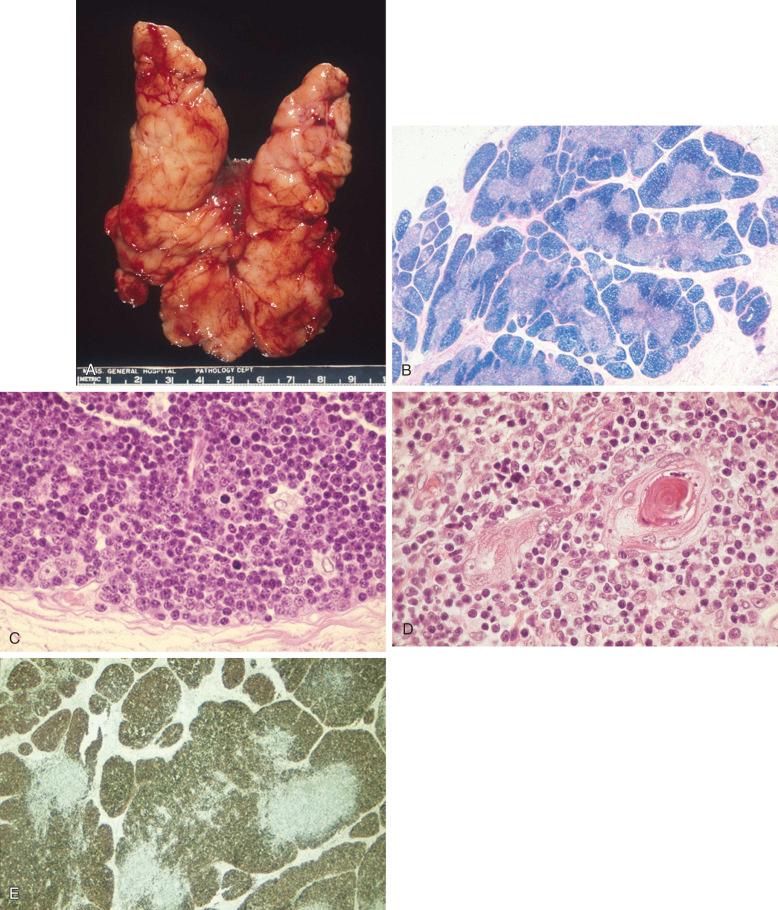
The thymus has a central lymphoid compartment—the thymic epithelial space—and a peripheral compartment—the perivascular space. The thymic epithelial space is divided into a cortex and a medulla; each is characterized by specialized epithelium and accessory cells, which provide the milieu for T-cell maturation. The cortex contains cortical epithelial cells, which are large cells with vesicular chromatin, prominent nucleoli, and pale cytoplasm that forms a reticular supporting meshwork. Phagocytic histiocytes (macrophages) are also present in the cortex, where they both present antigen and phagocytize apoptotic thymocytes. The medullary epithelial cells are smaller and spindle-shaped, and spherical whorls of epithelial cells with central keratinization, known as Hassall's corpuscles, are also found. The medulla contains dendritic cells that are similar to cutaneous Langerhans cells and lymph node interdigitating dendritic cells. Perivascular spaces are present in both cortex and medulla.
The lymphocytes of the cortex (cortical thymocytes) range in morphology from medium-sized blastic cells with dispersed chromatin and nucleoli in the outer cortex to somewhat smaller, more mature-appearing round lymphocytes in the inner cortex. Occasional apoptotic bodies and phagocytosis by histiocytes may be seen. The immunophenotype of most cortical thymocytes is that of precursor T cells (TdT + , CD1a + , CD4 + , CD8 + ). Medullary thymocytes are small, mature-appearing lymphocytes with round or slightly irregular nuclei and inconspicuous nucleoli. Lymphocytes in the perivascular spaces resemble those in the medulla. Both have the immunophenotype of mature T cells (TdT − , CD1a − , CD3 + , CD4 + or CD8 + ).
The thymic medulla also contains a particular population of B cells with dendritic morphology that expresses mature B-cell markers CD23, CD37, CD72, CD76, immunoglobulin (Ig) M, and IgD. These cells form rosettes with non–B cells and have been called asteroid cells. The close relationship with T cells and epithelial thymic cells suggests that they may play a functional role in the T-cell differentiation process. It has been suggested that they may be the cell of origin for primary mediastinal large B-cell lymphoma.
The thymic epithelial space begins to atrophy at age 1 year; it shrinks by about 3% per year through middle age and then 1% per year thereafter ; concomitantly, the perivascular space increases. The “fatty infiltration” noted in the adult thymus occurs in the perivascular space.
Lymph nodes are strategically located at branches of the lymphatic system throughout the body to maximize the capture of antigens and chemokines present in lymph drained from most organs via the afferent lymphatics ( Fig. 8-2 ). The lymph nodes are protected by an external fibrotic capsule with internal prolongations that form trabeculae, providing the basic framework for the organization of the different cellular, vascular, and specialized stromal components.
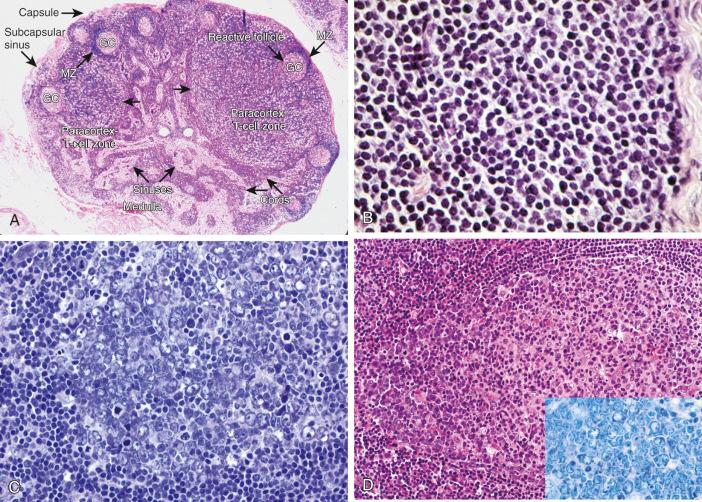
The cellular compartments are distributed among three discrete but not rigid regions: the cortex, paracortex, and medullary cords. The cortex or cortical area is the B-cell zone and contains the lymphoid follicles; the paracortex contains mainly T cells and T-cell antigen-presenting cells. The medullary cords in the inner area of the lymph node contain B cells, T cells, plasma cells, macrophages, and dendritic cells.
The initial cortical structure is the primary lymphoid follicle, composed of aggregates of naïve B cells with a small network of follicular dendritic cells (FDCs) (see Fig. 8-2, B ). The lymphoid cells are small and have round nuclei with dense chromatin and scant cytoplasm. These cells express mature B-cell markers as well as IgM, IgD, CD21, and CD23. Antigen stimulation of these cells generates the expanded and highly organized secondary lymphoid follicle with a mantle cell corona, a germinal center, and a dense meshwork of FDCs ( Fig. 8-3 ; see Fig. 8-2, C to F ).
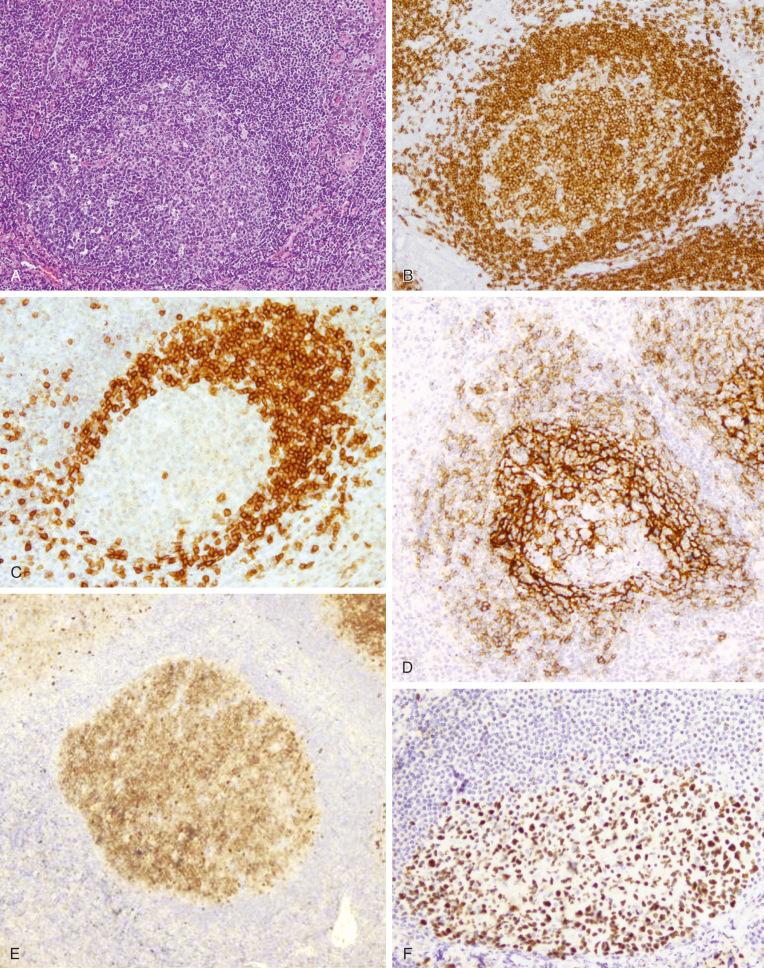
The mantle zone is composed mainly of the small B cells of the primary lymphoid follicle that are pushed aside by expansion of the germinal center. Like primary follicle B cells, mantle zone B cells express IgM, IgD, CD21, and CD23. Occasional B cells co-expressing CD5 are also located in this area but are difficult to identify in routine histologic sections. The mantle corona also contains memory B cells when the outer marginal zone is not developed.
The germinal center is a specialized lymphoid compartment in which the T-cell–dependent immune response occurs. This structure sustains the proliferative expansion of antigen-activated B-cell clones and the generation of high-affinity antibodies by the induction of antigen-driven somatic hypermutation of the immunoglobulin genes. Immunoglobulin genes also undergo the class or isotype switch from IgM or IgD to IgG, IgA, or IgE. This process is not exclusive to the germinal centers; it also occurs in other sites, to a lesser degree, in the T-cell–independent response. The germinal center also provides a microenvironment that selects the antigen-stimulated clones that produce high-affinity antibody, whereas B cells that do not produce high-affinity antibody to the specific antigen undergo apoptosis. Antigen-selected cells then exit the germinal center, becoming memory B cells or long-lived plasma cells.
Morphologically, the early germinal center contains predominantly small and large centroblasts (large, non-cleaved follicular-center cells). These cells are medium-sized to large-sized B cells with an oval to round vesicular nucleus containing one to three small nucleoli close to the nuclear membrane, as well as a narrow rim of basophilic cytoplasm; these features are best seen on Giemsa staining (see Fig. 8-2, C ). After several hours or days, the germinal center becomes polarized into two distinctive areas: the dark zone and the light zone (see Fig. 8-2, D ). The dark zone is composed predominantly of centroblasts. Mitotic figures are common in this area. Closely packed centrocytes (cleaved follicular-center cells) are also present in the dark zone (see Fig. 8-2, D , inset ). These are small to large B cells with irregular, sometimes deeply cleaved nuclei, dense chromatin, inconspicuous nucleoli, and scant cytoplasm that is not basophilic on Giemsa staining. Macrophages phagocytizing apoptotic nuclear debris are also present (tingible body macrophages). The light zone contains predominantly quiescent centrocytes.
The light zone also contains a high concentration of FDCs, and their vesicular and often double nuclei with small nucleoli are easily seen in this area (see Fig. 8-2, E ). Contrary to other dendritic cells, FDCs are derived from mesenchymal cells and are important organizers of the germinal centers and the T-cell–dependent immune response. These cells express a profile of molecules that attract B cells and T cells and facilitate the antigen-presenting process. Thus, FDCs secrete CXCL13, a chemokine that recruits B cells and T cells expressing CXCR5 (see Table 8-1 ). They also express CD23, the adhesion molecules ICAM-1 and VCAM-1, and complement receptors (CD21, CD35) that fix immunocomplexes (see Fig. 8-3 ).
Phenotypically, both centroblasts and centrocytes express mature B-cell antigens (CD19, CD20, CD22, CD79) and germinal-center markers such as BCL6, CD10, LMO2, or HGAL (see Fig. 8-3 ). Centroblasts lack surface immunoglobulin or express it at low levels because the immunoglobulin gene undergoes somatic hypermutation and class switch in these cells. Surface immunoglobulin is reexpressed by centrocytes that have a higher affinity for the driving antigen. BCL6 is an essential nuclear zinc-finger transcription factor required for germinal-center formation and the T-cell–dependent immune response. It is expressed in germinal-center B cells but not in naïve B cells, mantle zone B cells, memory B cells, or plasma cells. CD10 is a membrane-associated molecule (also known as common acute lymphoblastic leukemia antigen [CALLA]) that is normally expressed in early pro–B cells in the bone marrow but is lost in naïve cells and reexpressed in germinal-center cells. Its function is not well known, but it seems to be indispensable for germinal-center formation. CD10-positive mature lymphoid cells are restricted to germinal centers, and their identification outside this compartment should suggest the presence of a follicular lymphoid neoplasm. LIM-only transcription factor 2 (LMO2) and human germinal-center–associated lymphoma (HGAL) are more recent identified genes expressed in germinal-center cells. LMO2 is a transcription factor that plays an important role in hematopoiesis. It is normally expressed in the three lineages of the bone marrow, but in peripheral tissues it is only expressed in germinal-center cells. HGAL is a highly evolutionary conserved gene that is highly expressed in the cytoplasm of normal and neoplastic germinal-center cells, whose function is not well understood. An important functional phenotypic change in germinal-center cells is the downregulation of the antiapoptotic molecule BCL2, constitutively expressed in naïve and memory lymphoid cells. Thus, these cells are susceptible to death through apoptosis, and only the clones encountering the specific antigens will be rescued and survive in this microenvironment. Germinal-center B cells also express surface molecules involved in cell interactions with FDCs and T cells. In particular, CD40, CD86, and CD71 facilitate the association with T cells, whereas CD11a/18 and CD29/49d recognize the FDC ligands CD44, ICAM-1, and VCAM-1. Similarly, germinal-center lymphoid cells express receptors for the FDC molecules CD86D and interleukin (IL)-15, providing proliferative signals and B-cell–activating factor (BAFF), which triggers survival signals that facilitate the rescue of BCL2-negative cells from apoptosis.
Germinal centers contain specialized subpopulations of T cells that play an important role in the regulation of the B-cell differentiation process and T-cell–mediated immune response (see Fig. 8-3 ). One recently recognized subset is the follicular T-helper (T FH ) cell, which is mainly localized in the light zone and in the mantle zone area. These cells express CD4, CD57, ICOS, CXCL13, PD-1 (programmed death-1, or CD279), and CXCR5, the receptor for the CXCL13 chemokine also secreted by FDCs. T FH cells promote B-cell differentiation through activation-induced cytidine deaminase (AID), immunoglobulin class switch, and immunoglobulin production. Germinal centers also contain a subset of T regulatory (T-reg) cells that express CD4, CD25, and FOXP3 and play a role in preventing autoimmunity and limiting T-cell–dependent B-cell stimulation. These cells also seem to directly suppress B-cell immunoglobulin production and class switch. T-reg cells are also found in interfollicular areas.
Marginal zones are sometimes seen around follicles in lymph nodes, although these are usually not as prominent as those in the spleen; they are often more conspicuous in mesenteric lymph nodes (see Fig. 8-2, F ). Marginal-zone B cells have nuclei that resemble those of centrocytes, but with more abundant pale cytoplasm; they appear to be a mixture of naïve and memory B cells. In some reactive conditions, slightly larger B cells with even more abundant pale to eosinophilic cytoplasm appear in aggregates between the mantle zone and cortical sinuses; these are known as monocytoid B cells (see Fig. 8-2, G ). Like marginal-zone B cells, they appear to be a mixture of naïve and memory B cells.
The paracortex is the interfollicular T-cell zone (see Fig. 8-2, A ). This compartment contains mainly mature T cells and dendritic cells of the interdigitating cell subtype that specialize in presenting antigens to T cells ( Fig. 8-4, A ). This area is organized by the production of the chemokines CCL19 and CCL21 by stromal cells of the paracortex, particularly fibroblastic reticulum cells and endothelial cells of the high endothelial venules (HEVs) present in this area. These chemokines recruit the T cells and dendritic cells expressing their receptor, CCR7. The T cells in these areas are heterogeneous, with a predominance of CD4-positive cells; some CD8-positive and T-reg cells are also found. The interdigitating cells are positive for S-100, class II major histocompatibility complex (MHC), CD80, CD86, and CD40 but negative for CD1a, CD21, and CD35; they have complex interdigitating cellular junctions. In some reactive conditions, particularly those associated with rashes, the paracortical areas contain Langerhans cells that have migrated from the skin.
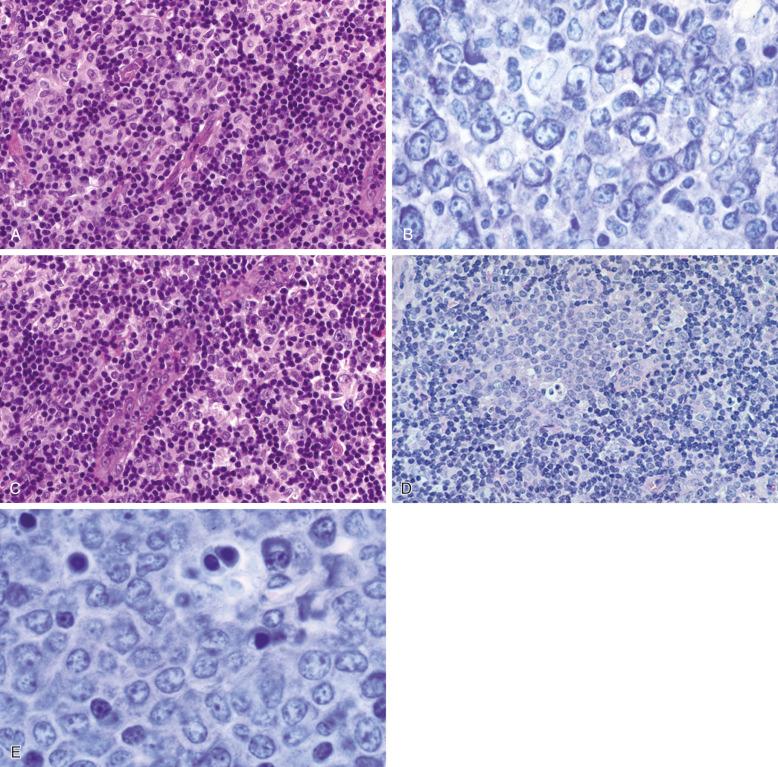
Interfollicular areas also contain isolated large B cells with immunoblastic morphology; these cells may be numerous in some reactive conditions. Immunoblasts are large cells similar in size to centroblasts but with prominent single nucleoli and more abundant basophilic cytoplasm (see Fig. 8-4, B ). These cells express mature B-cell markers and abundant cytoplasmic immunoglobulins and are considered intermediate steps toward plasma cells. A less frequent subset of large B cells with a dendritic morphology was recently identified in nodal T-cell areas. These cells carry immunoglobulin gene somatic mutations and express mature B-cell markers and CD40 but are negative for germinal-center markers (BCL6 and CD10), CD30, and CD27. The functional role of these cells is not known, but they resemble the thymic asteroid cell.
The paracortex contains high endothelial venules (HEVs), postcapillary venules through which both T and B lymphocytes enter the lymph node from the blood (see Fig. 8-4, C ). HEVs have large, plump endothelial cells whose nuclei often appear to virtually occlude the lumen. These endothelial cells express adhesion molecules that anchor circulating lymphocytes and also act as tissue-specific recognition molecules (called addressins) that bind to specific molecules on the lymphocytes (called homing receptors). These include E-selectin, P-selectin, VCAM-1, ICAM-1, ICAM-2, peripheral node addressin (peripheral lymph nodes), and mucosal addressin (mesenteric lymph nodes) cell adhesion molecules (MAdCAMs). The addressins bind to L-selectin and α 4 β 7 -integrins on the lymphocytes. Postcapillary venules in other tissues do not express lymphocyte adhesion molecules unless they are stimulated by inflammatory mediators; however, those in the lymph nodes express them constitutively and thus recruit lymphocytes continuously. The HEVs usually contain lymphocytes both within the lumen and infiltrating between the endothelial cells and the basement membrane.
Under some circumstances, collections of plasmacytoid dendritic cells may be found in the paracortex, usually at its junction with the medullary cords. These are medium-sized cells with dispersed chromatin, small nucleoli, and eccentric, amphophilic cytoplasm; they typically occur in small clusters, sometimes with apoptotic debris and histiocytes, mimicking a small germinal center (see Fig. 8-4, D ). These cells produce high amounts of interferon-α and function in the regulation of T-cell responses. They express CD4, CD68, granzyme B CD123, TCL1, and BDCA2 and lack specific markers of T-cell, B-cell, CD56, or myeloid differentiation.
The interaction among lymph, blood, and the different cell components of the lymph node is facilitated by a highly organized vascular system. Arteries arrive at the hilus and branch to reach the subcapsular area and paracortex, where the capillaries form loops and specialize into postcapillary HEVs. Lymph arrives through the afferent lymphatic vessels at the opposite pole of the node, which open to the subcapsular sinus, and flows through the trabecular and medullary sinuses toward the efferent lymph vessels at the hilus. Macrophages in the subcapsular sinuses capture large antigens, immune complexes, and viruses and may present them to nearby B cells in the cortical areas. Small soluble antigens may diffuse through the sinus wall and reach the cortical areas.
The nodal conduit system is a specialized structure that connects the lymphatic sinuses with the walls of the blood vessels, particularly the HEVs in the paracortex, allowing the rapid movement of small antigenic particles (around 5.5 nm and 70 kDa) and cytokines from the afferent lymph deep into the portal of entry of lymphocytes to the nodal parenchyma. This structure consists of small conduits composed of a core of type I and III collagen fibers associated with cross-linked microfibrils of fibromodulin and decorin, all of them surrounded by a basal membrane of laminin and type IV collagen. This entire conduit system is generated and wrapped by fibroblastic reticular cells. These cells are positive for vimentin, smooth muscle actin, desmin, and keratin 8 and 18. They also express CCL19/CCL21, serving as a homing mechanism for B cells and T cells expressing the receptor CCR7. Some studies suggest that these cells may acquire FDC markers under certain T-cell stimuli and may be the origin of the expanded meshwork of FDC that surrounds the HEV in angioimmunoblastic T-cell lymphoma.
The spleen has two major compartments—red pulp and white pulp—related to its two major functions as a blood filter for damaged formed elements of the blood and a defense against blood-borne pathogens, respectively. The white pulp organization is similar to that of the lymphoid tissue of lymph nodes ( Fig. 8-5, A to F ). Follicles and germinal centers are found in the malpighian corpuscles, and T cells and interdigitating cells are found in the adjacent periarteriolar lymphoid sheath. The red pulp also contains antigen-presenting cells; lymphocytes, particularly a subset of gamma-delta T lymphocytes; and plasma cells. A distinctive feature of the spleen is the presence of a prominent marginal zone, composed of lymphoid cells with abundant pale cytoplasm and macrophages, which surrounds both the B-cell and T-cell zones (see Fig. 8-5, D ).
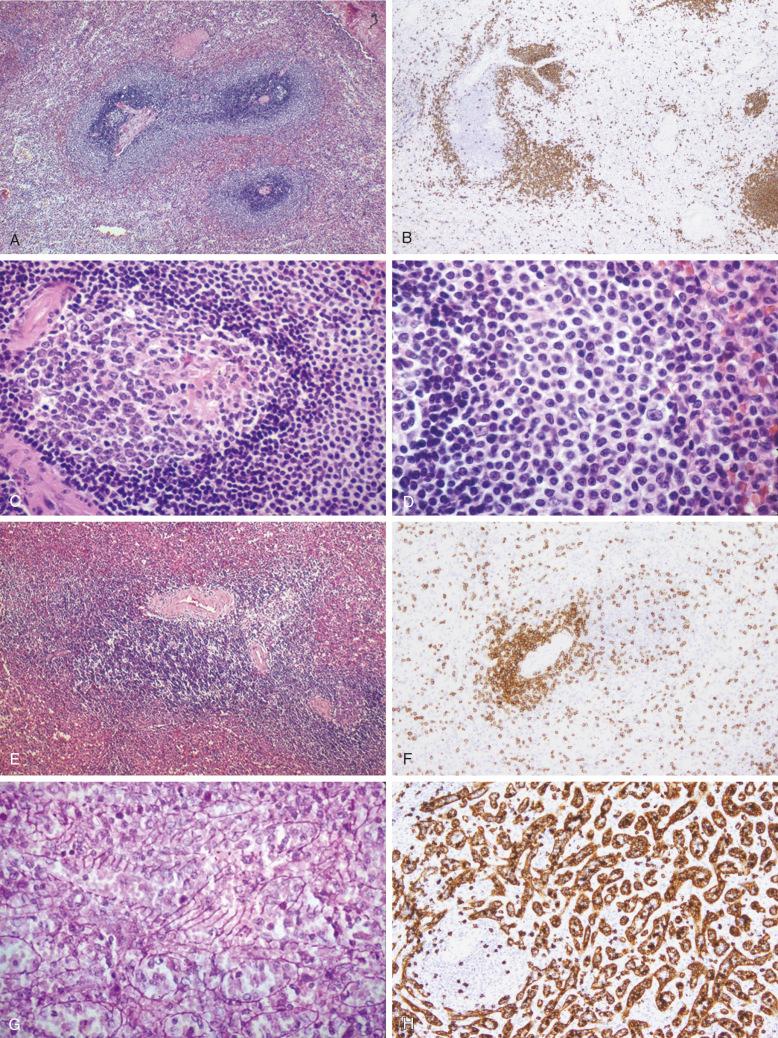
The B-cell and T-cell areas in the spleen are organized around the branching arterial vessels (see Fig. 8-5, A to F ). Similar to the lymph nodes, the T-cell and B-cell compartments are recruited and maintained by specific chemokines. CCL19 and CCL21 are produced mainly by stromal cells in the T-cell areas, and the FDCs secrete CXCL13; these chemokines recruit cells expressing the receptors CCR7 and CXCR5, respectively (see Table 8-1 ). T cells surround the arterioles in a discontinuous manner, whereas B-cell follicles may be found adjacent to the T-cell sheaths or directly attached to the arteriole without a T-cell layer (see Fig. 8-5, F ). A distinctive area of the splenic white pulp is the marginal zone, which is more evident in follicles with an expanded germinal center. B cells in this area have slightly irregular nuclei, resembling those of centrocytes but with more abundant pale cytoplasm (see Fig. 8-5, D ). These cells express CD21 and IgM, but contrary to mantle cells, IgD expression is negative or weak. These cells predominantly surround the follicles but are almost absent from the surface of the T-cell regions. Some studies in human spleen distinguish between an inner and outer marginal zone separated by a shell-like accumulation of CD4-positive T cells and a layer of peculiar fibroblasts that extend to the T-cell areas as a meshwork. These cells express smooth muscle α-actin and myosin, MAdCAM-1, VCAM-1, and VAP-1. In contrast to murine white pulp, human spleen lacks the marginal-zone sinus, where the arterial blood opens into the sinusoidal system. Instead, the human marginal zone is surrounded by a perifollicular area with more widely separated fibers and capillaries sheathed by abundant macrophages that are positive for sialoadhesin. A large amount of the splenic blood passes through this area, where the flow seems to be retarded. This anatomic relationship between an open blood area and the marginal zone seems to facilitate direct contact between blood-borne antigens and B cells.
The red pulp is composed of sinuses and cords. The sinuses form an interconnected meshwork covered by a layer of sinusoidal endothelial cells and surrounded by annular fibers of extracellular matrix; these annular fibers may be seen on periodic acid–Schiff staining (see Fig. 8-5, G ). The cells have cytoplasmic stress fibers that regulate the passage of blood cells. The capillaries open into the cords, and the blood cells that cannot pass through the sinusoidal cells are destroyed by the abundant macrophages resident in the cords. Sinusoidal blood flows into the venous system. The sinusoidal cells express endothelial markers such as factor VIII, but they are also positive for CD8 (see Fig. 8-5, H ). The red pulp cords also contain plasmablasts and plasma cells. Upregulation of CXCR4 in these cells may play a role in this movement because it binds to the CXCL12 expressed in the red pulp; on the contrary, CXCR5 and CCR7, which bind to the white pulp chemokines CXCL13, CCL19, and CCL21, are downregulated in these cells (see Table 8-1 ).
Specialized lymphoid tissue is found in association with certain epithelia, in particular, the gastrointestinal tract (gut-associated lymphoid tissue—Peyer's patches of the distal ileum, mucosal lymphoid aggregates in the colon and rectum), the nasopharynx and oropharynx (Waldeyer's ring—adenoids, tonsils), and, in some species, the lung (bronchus-associated lymphoid tissue). Collectively, this is known as mucosa-associated lymphoid tissue (MALT). In each territory, MALT comprises four lymphoid compartments: organized mucosal lymphoid tissue, lamina propria, intraepithelial lymphocytes, and regional (mesenteric) lymph nodes ( Fig. 8-6 ). The organized lymphoid tissue is exemplified by Peyer's patches of the terminal ileum and is also found in Waldeyer's ring. The lymphoid follicles are structurally and immunophenotypically similar to those found in lymph nodes. The only difference here is the expanded marginal zone, which tends to reach the superficial epithelium. MALT marginal-zone cells are morphologically similar to those found in the spleen. The interfollicular areas are occupied by T cells and interdigitating dendritic cells. The mucosal lamina propria contains mature plasma cells and macrophages and occasional B lymphocytes and T lymphocytes. These plasma cells secrete mainly dimeric IgA, but small populations producing IgM, IgG, and IgE are also present. The dimeric IgA and pentameric IgM are secreted into the intestinal lumen bound to the secretory component, a glycoprotein produced by the enterocytes. The T lymphocytes in the lamina propria are a mixed population of CD4-positive and CD8-positive cells, with a slight predominance (2 : 1 to 3 : 1) of the former. Intraepithelial lymphocytes are observed between the epithelial cells and are composed of a heterogeneous population of T cells. The predominant cells are CD3 + , CD5 + , and CD8 + , whereas 10% to 15% are CD3 + and double negative for CD4 and CD8. CD3-positive, CD4-positive cells are a minority, and only rare cells are CD56 positive. Most of the T cells express the alpha-beta form of the T-cell receptor (TCR), and around 10% of the cells are TCR gamma-delta. The epithelium above the Peyer's patches contains clusters of B cells and specialized epithelial cells called membranous or microfold cells (M cells). These cells are also found more dispersed in other parts of the gastrointestinal tract and other mucosal sites, particularly in the epithelium over lymphoid follicles. M cells play a sentinel role for the mucosal immune system by capturing luminal antigens and delivering them to the underlying immune cells. The basic structure of mesenteric lymph nodes is similar to that of other lymph nodes, but the marginal zone surrounding the follicles is usually expanded and visible.

The organization of the immune system in mucosal sites is orchestrated by the coordinated action of several adhesion molecules, chemokines, and their respective receptors. Lymphoid cells that respond to antigen in the MALT acquire homing properties that enable them to return to these tissues. This homing is mediated in part by expression of high levels of α 4 β 7 -integrin, which binds to MAdCAM-1 on HEVs in gut-associated lymphoid tissue. In addition, the MALT immune cells express α e β 7 -integrin (CD103), whose ligand E-cadherin is expressed on the basolateral surface of the epithelial cells. Epithelial cells also secrete CCL25, which recruits immune cells expressing its receptor CCR9 (see Table 8-1 ).
Become a Clinical Tree membership for Full access and enjoy Unlimited articles
If you are a member. Log in here